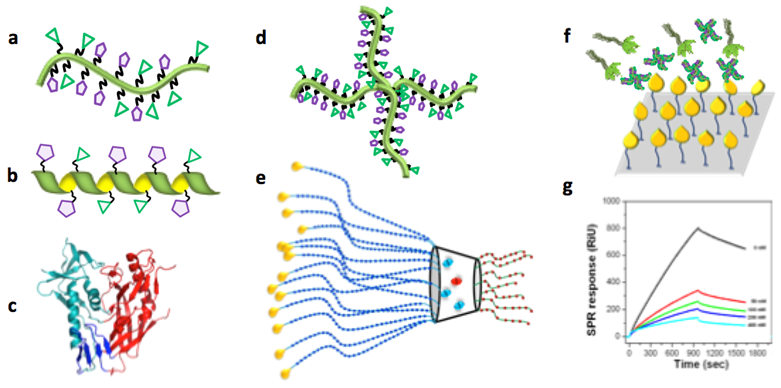Nov 2022

Sequence controlled polymers have been attracting more and more attention to deliver the desired properties to the advanced materials by the help of their precisely controlled compositions and architectures. Understanding the specific multivalent carbohydrate-protein interactions is crucial to determine the structure-property relationships and to design accordingly the next generation of functional glycomaterials. Therefore, we investigate the structure-property relationships between the mammalian lectins and multivalent carbohydrate polymers, which may have applications for anti-adhesion therapy.1-4 Moreover, we have investigated the affinity of poly(mannose-methacrylate), helical glycocopolypeptides, gp120, start shaped glycopolymers, and cyclodextrin centered glycopolymers with a selected mannose binding lectin (DC-SIGN) that exists on dendritic cells, using SPR technique. Selected members of a glycopolymer library were used to demonstrate the interactions between DC-SIGN and mannose rich polymers. We extend this study to a broader set of polymers to examine the effect of chain length, end group, architecture, thermoresponsive block, and number of arms in the star shaped polymers on the lectin binding.

Fig. 1: Schematic representation of (a) linear GP, (b) helical glycocopolypeptide, (c) glycoprotein 120 (gp120), (d) star shaped GP, (e) cyclodextrin centred GP, (f) SPR measurement on glycopolymer-DCSIGN competition in solution, (g) SPR response-time for the interaction of DC-SIGN & gp120.
References:
1. Hartweg, M.; Jiang, Y.; Yilmaz, G.; Jarvis, C. M.; Nguyen, H. V. T.; Primo, G. A.; Monaco, A.; Beyer, V. P.; Chen, K. K.; Mohapatra, S.; Axelrod, S.; Gómez-Bombarelli, R.; Kiessling, L. L.; Becer, C. R.; Johnson, J. A., Synthetic Glycomacromolecules of Defined Valency, Absolute Configuration, and Topology Distinguish between Human Lectins. JACS Au 2021, 1 (10), 1621-1630.
2. Abdouni, Y.; ter Huurne, G. M.; Yilmaz, G.; Monaco, A.; Redondo-Gómez, C.; Meijer, E. W.; Palmans, A. R. A.; Becer, C. R., Self-Assembled Multi- and Single-Chain Glyconanoparticles and Their Lectin Recognition. Biomacromolecules 2021, 22 (2), 661-670.
3. Blakney, A. K.; Abdouni, Y.; Yilmaz, G.; Liu, R.; McKay, P. F.; Bouton, C. R.; Shattock, R. J.; Becer, C. R., Mannosylated Poly(ethylene imine) Copolymers Enhance saRNA Uptake and Expression in Human Skin Explants. Biomacromolecules 2020, 21 (6), 2482-2492.
4. Yilmaz, G.; Uzunova, V.; Napier, R.; Becer, C. R., Single-Chain Glycopolymer Folding via Host–Guest Interactions and Its Unprecedented Effect on DC-SIGN Binding. Biomacromolecules 2018, 19 (7), 3040-3047.
Prof. Dr. Remzi Becer has completed his PhD at Eindhoven University of Technology, the Netherlands (2009). He received a Marie Curie Research Fellowship (2009–2011) and joined University of Warwick, UK. He was awarded a Science City Senior Research Fellowship (2011–2013) to start up his independent research group at the same university. He was appointed (2013–2018) as a Senior Lecturer in Materials Science at Queen Mary, University of London. He has moved his group back to Warwick in 2019 and is a Professor in Sustainable Polymer Chemistry at the University of Warwick, associate editor of European Polymer Journal (2018‐), and the chair of the Macro Group UK (Royal Society of Chemistry).
For more information visit www.becergroup.com and follow us on Twitter @remzibecer.